JOLTS stands for Job Openings and Labor Turnover Survey. The February 2012 statistics show there were 3.66 official unemployed people hunting for a job to every position available*. There were 3,498,000 job openings for February 2012, an increase of 0.6%, from the previous month of 3,477,000. This is no change from January 2012 in actual job openings. Job openings have increased 60% from their July 2009 trough. Yet opportunities are still way below the 1.8 persons per job opening at the start of the recession, December 2007. Below is the graph of February official unemployed, 12.806 million, per job opening.
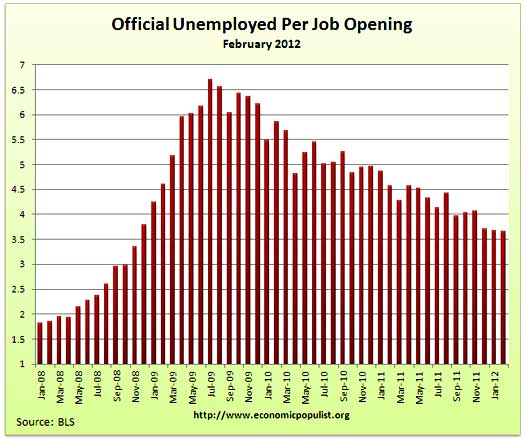
If one takes the official broader definition of unemployment, or U-6, the ratio becomes 6.73** unemployed people per each job opening for February. The February U-6 unemployment rate was 14.9%. Below is the graph of number of unemployed, using the broader U-6 unemployment definition, per job opening.
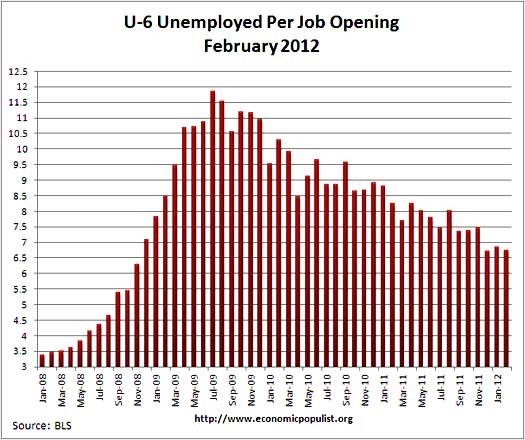
If you do not like the use of U-6 to look at the real number of people looking for a job to actual opportunities, consider this number. In February 2012, of those not in the labor force, 6,378,000 were actually wanting a job. U-6 only includes 2,608,000 of these people.
The rates below mean the number of openings, hires, fires percentage of the total employment. Openings are added to the total employment for it's ratio. Opens has no change while both hires and separations increased a 10th of a percentage point.
- openings rate - 2.6%
- hires rate - 3.3%
- separations rate - 3.1%
- fires & layoffs rate - 1.3%
- quits rate - 1.6%
Below are raw job openings, still below the 4.3 million pre-recession levels.
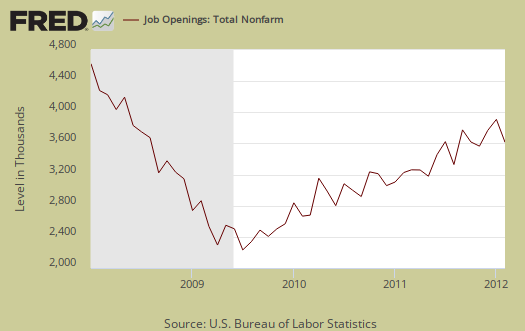
February's hires were 4,385,000, a 3.44% change from January's 4,239,000 hires.
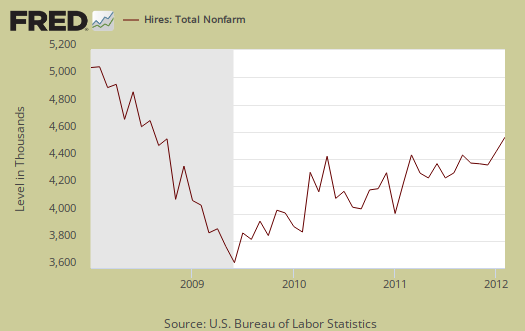
Below are total job separations, 4,092,000, a 1.87% increase from last month's 4,017,000. The term separation means you're out of a job through a firing, layoff, quitting or retirement. The report has a breakdown of separations, hires and openings across occupational categories. Layoffs and firings were 1,673,000 of the total 4,092,000 and to pre-recession levels.
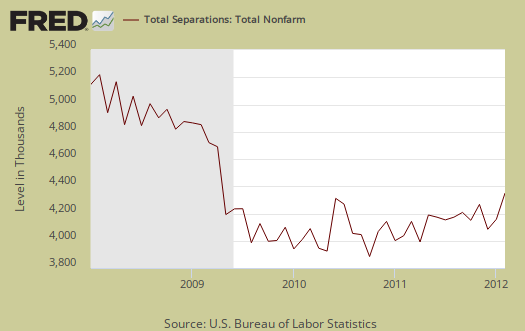
For February, of total separations, the quits were 51.1% whereas layoffs and fires were 40.9%. Below are quits minus discharges and layoffs. When quits comes close to firings that means people have little choice in employment. You want to see choice, or quits, rise and be much higher than firings. The below graph shows people still do not have that many options when it comes to a job, for the ability to quit your job, shown in the number of quits, 1,961,000 for February, is still way below pre-recession levels of 2.8 million. The ratio of quits to firings, is nowhere near the 2009 mass firings and layoffs, which was like Schindler's list.
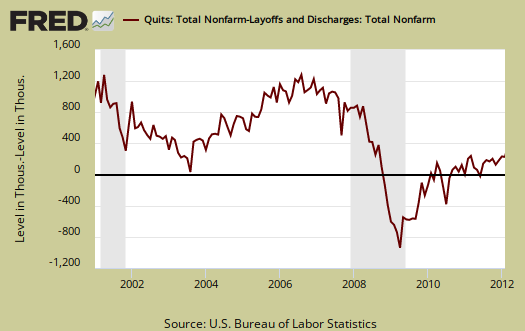
Other types of job separations are due to retirement, death, disability and inter-company transfers. While the JOLTS report notes the number of other separations for total nonfarm in February 2012 was 12 percent higher than at the end of the recession in June 2009, we noticed a fairly noisy statistic generally and it's not clear if this increase implies more people are being forced into early retirement or simply more comfortable retiring, and moving to different jobs within the company, a result of baby boomers or a combination of all of the above.
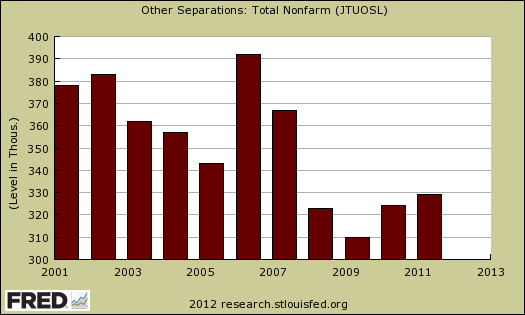
The JOLTS takes a random sampling of 16,000 businesses and derives their numbers from that. The survey also uses the CES, or current employment statistics, not the household survey as their base benchmark, although ratios are coming from the household survey, which gives the tally of unemployed.
The BLS was kind enough to make a credible Beveridge Curve graph, reprinted below. The Beveridge curve shows the official unemployment rate vs. the job openings rate, over time. If you see a bunch of data points to the far right, that's bad, it means there is long term unemployment and not enough jobs. Look at how we're stuck to the right. December 2011 moved left and up. That means job openings increased, the unemployment rate decreased. The February 2012 unemployment rate was 8.3%. A right and up move in the Beveridge curve can indicate a skills mismatch, so this graph also refutes the corporate lobbyists claim there is a skills shortage per their cheap labor arbitrage agenda. The green, representing the 2009 time period, shows how fast we went to the right and the purple, which is 2010-2012, means we are stuck in job market malaise. The flat and left move on the Beveridge curve is too great for while the unemployment rate is going down, job openings are not going up. Notice how awesome 2000 was for landing a job in the graph below.
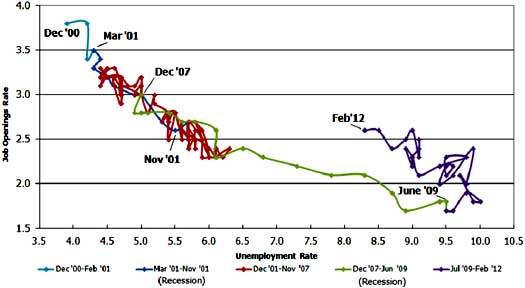
JOLTS includes part-time jobs and does not make a distinction between part-time, full-time openings. A job opening reported to the survey could literally be take out the trash twice a week and be counted. This is a shame, it would be nice to know a little more about the quality of these new opportunities.
For the JOLTS report, the BLS creates some fairly useful graphs, some of which were reprinted here, and they have oodles of additional information in their databases, broken down by occupational area. The Saint Louis Federal Reserve also had loads of graphing tools for JOLTS. Below is a reprint of the BLS graph showing the percent change in job openings from the July 2009, there were no jobs trough to show what general kind of growth we've seen, although these categories are broad and include part-time, low paying crappy jobs along with career oriented ones per category.
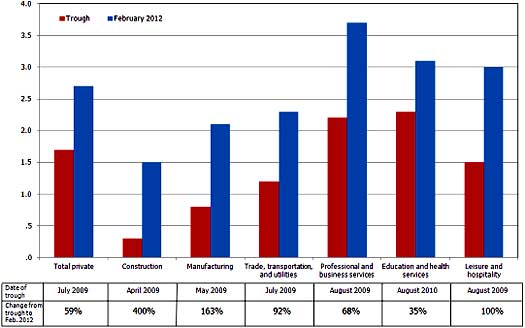
*The BLS rounds up to 1 decimal place.
** is defined as the official unemployed plus people who are in part-time jobs for economic reasons plus the marginally attached. The marginally attached,
, are officially not part of the civilian labor force,
, and also not seasonally adjusted. The above graph was created by the seasonally adjusted levels of the unemployed, part-time for economic reasons and the marginally attached. The raw U-6 totals can also be calculated by this formula, which gives a slightly lower ratio of 6.71.
where

6.73 for U-6, not 7.73, typo, now corrected
There was a typo earlier but one could see the mistake from the U-6 graph.
Come on folks, 500 people have read this overview by the time I noticed this error. When ya see a mistake, please let us know so we can correct it. Nothing worse than bad numbers floating around the Internets.
You've Got 32 "Likes" and 6 Comments over on Facebook
http://www.facebook.com/ucubed
This article was "shared" earlier today.
I was surprised and glad to see it on my Facebook page.
The Economic Populist is on Facebook
http://www.facebook.com/EconomicPopulist
If someone wants me to read a comment on any article, you have to leave a comment here, there are just too many things to look at and Facebook for this site is more of a convenience.
plus I like to call it "spybook", ;)
Anyway, nice page and glad people liked the information. I do try to number crank out something from the data which hasn't been already amplified by the government group releasing their report.